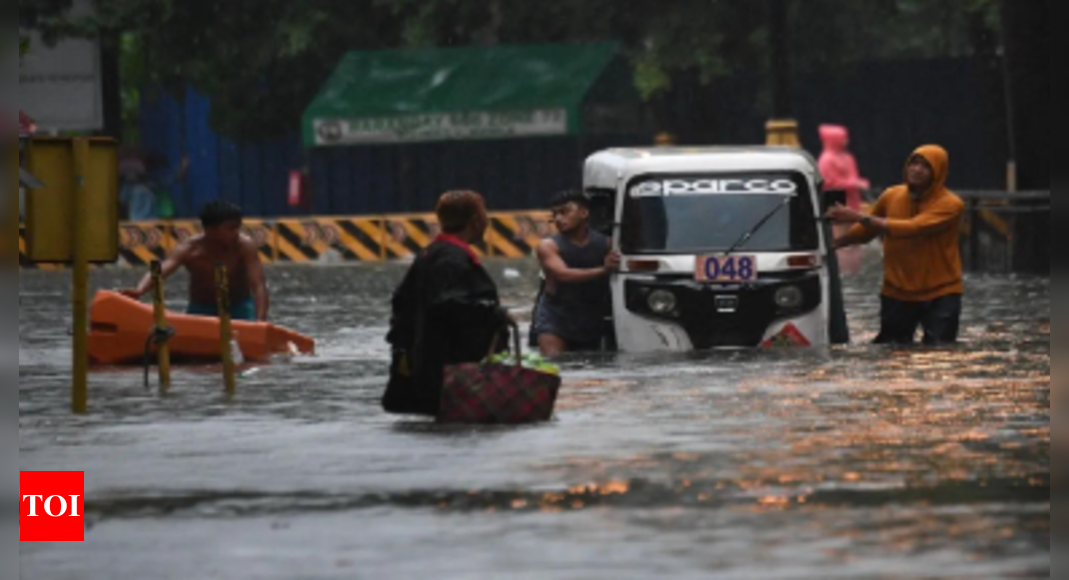
Typhoon Gaemi and the southwest monsoon rains have caused severe flooding that devastated the Philippine capital, Manila, and large parts of Luzon Island on Wednesday. The downpours have led to knee-deep flooding in several areas, prompting the government to initiate evacuations and suspend schools and offices, according to Xinhua news agency.
Residents near Manila Bay and riverbanks were evacuated as local authorities worked to ensure safety in the flood-affected regions.The situation was dire enough to cause the closure of government offices and suspension of classes across all levels in the national capital region. The Philippine Senate and the House of Representatives also cancelled their sessions for the day.
The Ninoy Aquino International Airport faced significant disruption, with at least 16 flights cancelled on Wednesday morning. Many roads in the capital region became impassable due to the floods, stranding commuters and halting traffic. Some vehicles stalled when attempting to navigate the submerged roads.
The typhoon has caused substantial damage, including the destruction of a shanty colony near Manila Bay. Although the government has yet to confirm any fatalities linked to the flooding, a 14-year-old boy was reported missing after he was swept away while wading through floodwaters in Rizal province, east of Manila.
According to the Philippine Atmospheric, Geophysical and Astronomical Services Administration (PAGASA), Typhoon Gaemi intensified as it moved northwestward over the Philippine Sea, with wind speeds reaching 155 km per hour and gusts up to 190 km per hour. The agency warned that Gaemi would continue to bring heavy rainfall throughout Wednesday, with a risk of further flooding and rain-induced landslides.
The southwest monsoon, further strengthened by Gaemi, is expected to produce moderate to intense rainfall across Luzon until Friday, affecting parts of the Visayas region and northern Mindanao.
Typhoon Gaemi, the third major storm to hit the Philippines this year, is forecast to exit the country by Wednesday night or early Thursday. The Philippines, with an average of 20 typhoons annually, remains highly vulnerable to tropical cyclones that bring heavy rains, flooding, and strong winds, leading to significant casualties and damage to crops and properties.
Residents near Manila Bay and riverbanks were evacuated as local authorities worked to ensure safety in the flood-affected regions.The situation was dire enough to cause the closure of government offices and suspension of classes across all levels in the national capital region. The Philippine Senate and the House of Representatives also cancelled their sessions for the day.
The Ninoy Aquino International Airport faced significant disruption, with at least 16 flights cancelled on Wednesday morning. Many roads in the capital region became impassable due to the floods, stranding commuters and halting traffic. Some vehicles stalled when attempting to navigate the submerged roads.
The typhoon has caused substantial damage, including the destruction of a shanty colony near Manila Bay. Although the government has yet to confirm any fatalities linked to the flooding, a 14-year-old boy was reported missing after he was swept away while wading through floodwaters in Rizal province, east of Manila.
According to the Philippine Atmospheric, Geophysical and Astronomical Services Administration (PAGASA), Typhoon Gaemi intensified as it moved northwestward over the Philippine Sea, with wind speeds reaching 155 km per hour and gusts up to 190 km per hour. The agency warned that Gaemi would continue to bring heavy rainfall throughout Wednesday, with a risk of further flooding and rain-induced landslides.
The southwest monsoon, further strengthened by Gaemi, is expected to produce moderate to intense rainfall across Luzon until Friday, affecting parts of the Visayas region and northern Mindanao.
Typhoon Gaemi, the third major storm to hit the Philippines this year, is forecast to exit the country by Wednesday night or early Thursday. The Philippines, with an average of 20 typhoons annually, remains highly vulnerable to tropical cyclones that bring heavy rains, flooding, and strong winds, leading to significant casualties and damage to crops and properties.









